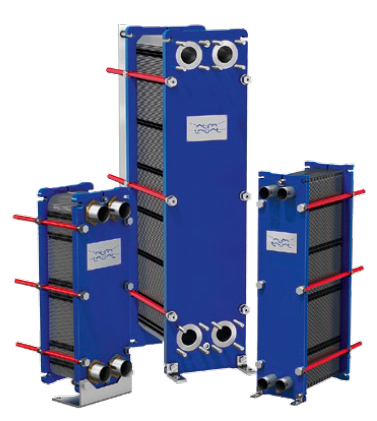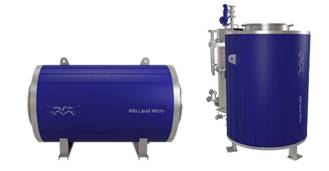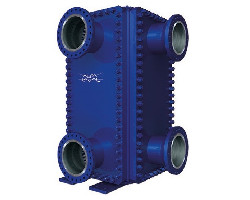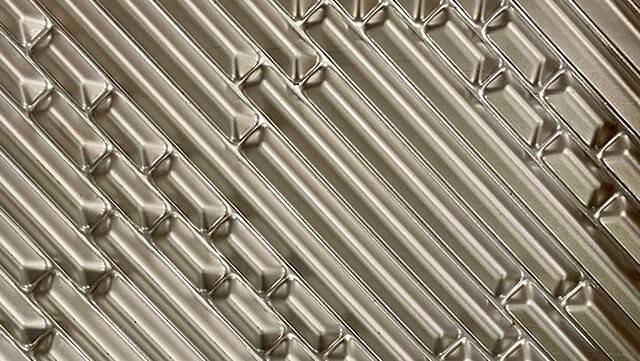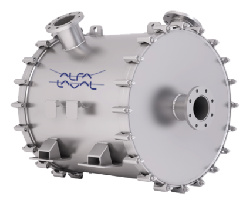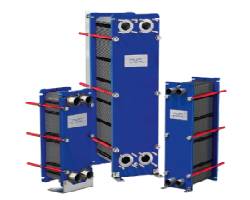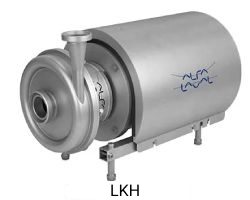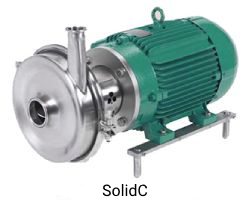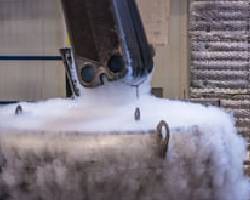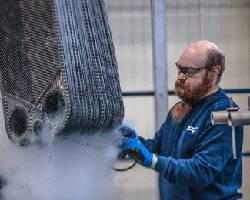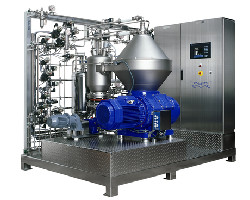Strategies for Sustainability
Next-Generation Features and Process Design to Improve Process Efficiency and Product Lifetime while Minimizing Negative Environmental Impact
Sustainable operation of plant equipment is more of a focal point than it has ever been, and sustainable product technology and operating methods are at the forefront of equipment manufacturing design. The reduction of emissions does not mean compromise on production output; developments in technological efficiencies are the optimal way to simultaneously meet sustainability and production targets within your business while continuing to maintain product quality standards.
Valutech, through its partners, is offering product solutions with the latest features aimed at improving efficiency during operation, maximizing uptime, and extending product lifetime with the goal of achieving the most sustainable possible industrial or commercial process. Servicing of process equipment is key to ensuring the maximum possible efficiency of a unit over its lifetime; click here to learn more about the services that Valutech offers for your existing process equipment and how they contribute to regaining lost efficiencies and extending product lifetime.

Valutech is supplying process equipment that aids in employing the following strategies in energy efficiency and implementing solutions for a sustainable future:
This page highlights the features on our product line that can aid in the above efficiency parameters, and thus contribute to lower energy and resource consumption, carbon emissions, wasted heat, and unnecessary turnover of equipment within all sectors.
Sustainability Features and Practices for Heat Exchangers
When designing a fluid-handling system, there are a number of methods to improve process efficiency, thus directing resources strictly to the process rather than dealing with inefficiencies and waste. For example, heat loss from inefficient heating-duty heat exchangers creates a higher demand for service fluids, meaning more energy is spent on heating the service fluid than otherwise necessary. Therefore, efficient heat exchangers contribute towards decarbonization of industrial and commercial processes while saving on resource and energy costs through their usage.
Furthermore, an efficient system will create opportunities to reuse wasted heat; for example, hot service water can be reused in another part of the process rather than being sent to waste. Using heat exchangers to take advantage of potential system efficiencies is critical in creating economical savings and minimizing the wasting of finite natural resources.
New Efficiency Features
for Brazed Plate Heat Exchangers
Free cooling via chiller bypass is one such example of a specific application using gasketed plate-and-frame heat exchangers sustainably. During the colder months of the year, chillers in industrial processes can be bypassed by water chilled via free cooling. This opens up the opportunity to turn off chiller systems that are a large source of energy consumption within industrial processes, leading to energy savings and more sustainable year-round operation. When ambient temperatures drop below a certain threshold, water from cooling towers can be supplied at temperatures sufficient for an existing industrial process. During the shoulder months, chiller bypass can also be performed intermittently (also known as hybrid cooling) for hours or days at a time, based on ambient temperatures during that period. A typical free cooling system can reduce energy consumption in such a process by a value on the order of 770,000 kW·h per year, without even accounting for the possibility of hybrid cooling. For a more detailed calculation and more information on free cooling, please click here.
Another specific example of using additional heat exchangers to create sustainable solutions is within data centers; it is estimated that 90% of electricity used with data centers is converted into heat. When choosing a heat exchanger with sustainability in mind, it must be able to provide sustainable service over a long lifetime, mitigating resource costs associated with its manufacture. Click here to explore features of Alfa Laval gasketed plate-and-frame heat exchangers that contribute to long lifetimes of sustainable service in a wide variety of heat transfer applications.
A brief list of the direct applications of sustainable heat exchanger product design can be seen below:
- Reduced energy consumption
- Improved heat recovery
- More efficient domestic heating
- Waste heat capture and re-usage (for example, in district heating)
- Minimization of refrigerant emissions
- More efficient air-conditioning
- Reduced operation costs
- High-pressure refrigeration units for natural refrigerants
The following section introduces sustainability features for the various Alfa Laval plate heat exchanger product lines that Valutech offers. In addition to these lines, Valutech also stocks brazed plate heat exchangers which are optimal for use with natural refrigerants due to their compact design, plate patterns optimized for efficient heat transfer, and high design pressure. Click here for detailed information on Valutech’s refrigeration line of brazed plate heat exchangers.
For more information on product features and sustainability strategies involving Valutech’s heat exchanger lines, please see the following product sustainability outlines:
Sustainability Features and Practices for Pumps
Optimal pump selection and configuration can lead to lower resource consumption and emissions, resulting in significant operating-cost savings. Alfa Laval LKH pumps are 30%+ more efficient than comparable mid-range centrifugal pumps, leading directly to reductions in energy consumption; a significant number when one considers that pumping systems make up 25% of the energy demands of a typical plant (where energy usage is on the order of 100 to 10,000 kWh/h).
High efficiency pumping reduces electricity and cooling water demands, resulting in direct environmental and economical benefits. The efficiency of a pump is proportional to the distance between Best Efficiency Point (BEP) of a pump and the duty flow rate; operating at the closest point offers the best possible efficiency for a given pump. This is critical since energy costs can account for over 90% of the costs associated with the life cycle of a pump.
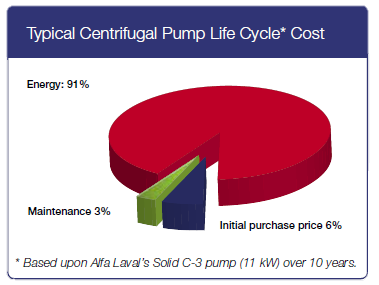
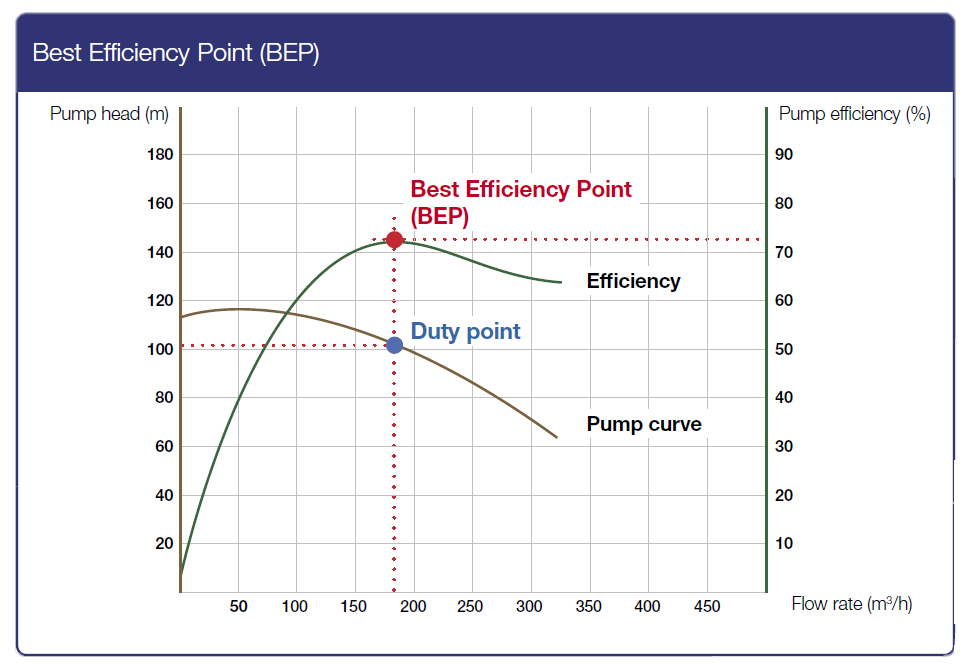
The optimization of pumps is integral to energy savings and sustainable operation within pharmaceutical and biotechnology plants. For example, Alfa Laval UltraPure pumps are used in large WFI applications that run 24/7 due to being designed with high quality construction to ensure long lifetimes of seals and other mechanical components.
The reduction of recirculation within the pump head minimizes heat generation and vibration that would otherwise wear the pump down more quickly. The longer the uptime of a pump in a hygienic setting, the less costs and resource usage are incurred as a result of maintenance and the subsequent cleaning cycles used to prevent contamination.
Separation Technology for Oil-Separation Applications
Separation technology is a core component of processes in the food, beverage, brewery, edible oils, pharmaceutical and personal care industries, as well as the energy generation and wastewater treatment industries. In these applications, various technology forms are used to separate liquids from solids or other liquids with the aim of producing cleaner process lubricants and service fluids, extracting valuable by-products, and reducing the volume of waste sent to disposal.
Alfa Laval centrifugal disc-stack separators are designed with a number of features to ensure continuous operation with minimal downtime, while providing energy savings against comparable separation technology. Lower power consumption and less downtime as a result of bypass-flow installation are just a few advantages of Alfa Laval centrifugal separation technology; a complete list of sustainability features of Alfa Laval’s disk-stack separation units can be seen below:
Realize Energy Savings with
Innovative Separation Technology
Hermetic Design

An airtight bottom-feed inlet and outlet with smooth flow paths reduces and shear force applied to the product and prevents oxygen pick-up for favourable fluid dynamics conditions. This allows for a higher degree of process control and the ability to consistently operate efficiently and reap energy savings.
eDrive™

An energy-efficient direct drive system with relatively few rotating parts ensures consistent product quality while drastically reducing wear-related maintenance and extending product lifetime.
eMotion™

The addition of a vacuum pump reduces air pressure in the cavity between the bowl and frame reduces friction; this means that more of the motor energy load goes towards operation rather than waste heat generation, and has the added benefit of reducing noise and improving hygiene.
The efficiency of a separation system is evaluated based on the relative amount of a target fluid it is able to isolate and recover — separating less of a reusable process fluid into the waste stream (and therefore recovering more of it) results in less costs necessitated by its replacement. When considering how costly the production of lubricants and process oils can be to the environment, reducing global demand via efficient separation technology is a significant step towards sustainable operation in manufacturing industries. A consequential benefit of reducing the volume of process waste streams is that less disposal costs are incurred, and on a larger scale, the disposal of waste as a result of human activity is reduced.
In addition to improving process sustainability by reducing energy costs, there are a number of other direct and indirect methods for separation technology to contribute to sustainability efforts. For example, separators in the metalworking industry can be employed to remove solid particles in addition to oils and greases, preventing unnecessary wear to tools when a process fluid (such as a lubricant or coolant) is reused. Further, the costs of dirty process fluids extend beyond necessitating maintenance; they can also cause costly quality issues in end-products and even exacerbate health issues in those that are working with them. For more details on the disc-stack centrifuge models Valutech offers, please click here.
For more details on the products featured on this page, please browse the following pages:
Valutech is partnered with Alfa Laval, the world’s largest manufacturer of gasketed plate and frame heat exchangers, to provide a wide range of models with connections ranging from 1” to 30”.
Alfa Laval’s Compabloc® welded plate heat exchanger is an ideal replacement for most shell and tube heat exchangers in their traditional applications. Compabloc® exchangers are maintainable and can be used for liquid-liquid, condenser and reboiler applications.
Centrifugal Pumps
Alfa Laval’s line of centrifugal pumps focus on evaporation, high-pressure, and self-priming applications, while also being well-suited for CIP. Valutech carries both the premium LKH, and cost effective SolidC lines; for those interested in the now-obsolete MR Liquid Ring line of pumps, please see the replacement: LKH Prime.
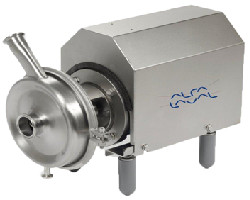
UltraPure Pumps for
Pharma and BioPharma
Designed for the pharmaceutical and biotechnology, Alfa Laval’s line of UltraPure models build on the features provided in the base models, while adding added efficiency and sanitary features. All products are designed with a high level of repeatability and reduction of contamination at the forefront, and come with comprehensive documentation for validation and qualification.
Available Models: LKH UltraPure, LKH Prime UltraPure, SolidC UltraPure, SX UltraPure
Valutech’s comprehensive reconditioning process restores unit functionality and extends the lifespan of your heat exchangers.
Please click here for information on our next webinar on sustainability features.

